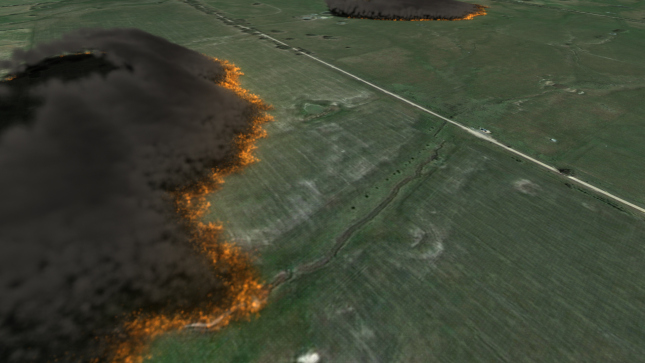
Visualisation of a bushfire spread simulation using the Spark software. CSIRO photo.
The CSIRO and AFAC, the National Council for Fire and Emergency Services have signed an agreement to develop a nationally consistent bushfire modelling and prediction capability.
The partnership involves the development of Spark Operational, a cutting-edge bushfire simulation tool based on CSIRO’s ‘Spark’ fire prediction platform.
Fire and emergency services agencies across Australia will be able to use Spark Operational, opening bushfire prediction opportunities across borders and over different landscapes.
CSIRO’s Spark platform combines current fire behaviour knowledge with state-of-the-art simulation science to produce predictions, statistics and visualisations of bushfire spread, as well as simulating hours of fire spread across a landscape in a matter of seconds.
AFAC’s Fire Prediction Services Group will work with CSIRO to improve existing technology and build a national system that allows for consistent bushfire predictions to support emergency service and response teams across borders.
Phase one of the technology’s implementation commenced in January 2021, with further developments ensuring it will become fully operational over the next three years.
With each phase of its implementation, Spark Operational will be grown and adapted into a tool that all agencies nationwide can tailor to specific landscapes and bushfire behaviour, enabling them to better predict – and thereby protect – local environments.
CSIRO chief executive Dr Larry Marshall said the innovation builds on decades of expertise.
“Our solutions from science have protected Australians from the threat of bushfires for over 70 years, from roadside fire danger signs to advanced burnover protection materials,” Dr Marshall said.
“But 2020 changed the game forever. So we have changed our game, too, by unleashing new science and technology to protect our firefighters and Australian communities.
“We believe this advanced system will help firefighters outthink fire, to anticipate its actions, and to get ahead of it, so they can beat it.
“Spark is a great example of combining environmental, digital and materials science and listening to Australia’s front-line responders to deliver a real-world solution that works for them.
“Spark is a cutting-edge platform, based on today’s breakthrough technology but built on a strong foundation of research into understanding and predicting the behaviour and spread of bushfires.”
AFAC CEO Stuart Ellis said the new technology will support fire agencies to keep communities safe.
“Spark Operational will play a significant role in allowing our emergency response teams to effectively plan for and respond to fire emergencies in a variety of landscapes and climates,” Mr Ellis said.
“It was identified as the best solution to use to help achieve a nationally consistent system that will take the nation to the next generation of firefighting intelligence, and ensure we are protecting as many lives and assets as possible across multiple scenarios, mitigating the dangers of bushfire.”
Through a partnership with AFAC, Minderoo Foundation is supporting the development of Spark Operational as part of its Fire Shield Mission, which aims to detect and extinguish dangerous fires within an hour by 2025.
CEO of Minderoo’s Flood and Fire Resilience Initiative Adrian Turner said the development came at a critical time.
“The Black Summer Bushfires burned with devastating impact, in extremely dry fuels and at a scale that is rarely seen, driving extreme fire behaviour, which meant that the modelling was not able to accurately predict spread,” Mr Turner said.
“The experience last summer has highlighted the need for better decision support tools to help firefighters protect people and the environment.
“Fire services will be able to test this tool during this next fire season, and this pilot project is a critical step towards better supporting firefighter decisions across a full range of fuel types to inform the earlier detection of fires in the future.”
The creation of a nationally consistent bushfire modelling and prediction capability was recommended by CSIRO in its Climate and Disaster Resilience report to the Commonwealth Government last year.
Stay up to date by getting stories like this delivered to your mailbox.
Sign up to receive our free weekly Spatial Source newsletter.












